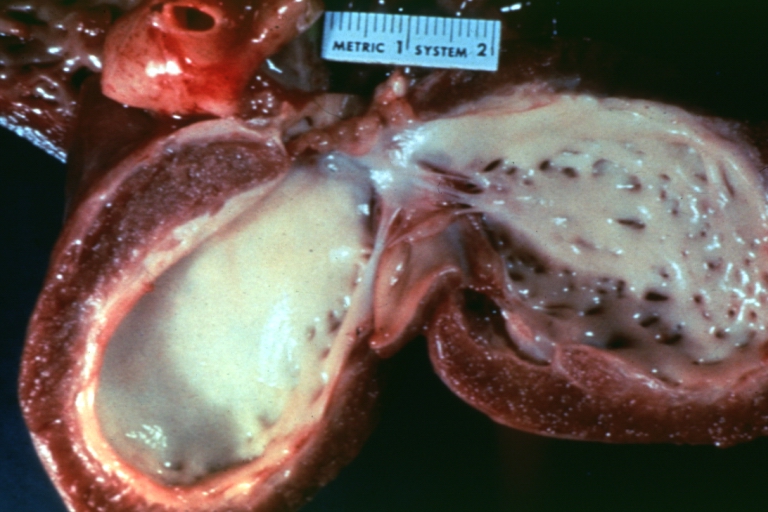WBR0042
| Author | PageAuthor::Gonzalo Romero |
|---|---|
| Exam Type | ExamType::USMLE Step 1 |
| Main Category | MainCategory::Pathology |
| Sub Category | SubCategory::Cardiology |
| Prompt | [[Prompt::A 21-year-old healthy male college student is playing in the football finale game across local colleges when he suddenly falls on the ground while running. The player is found unresponsive. The Emergency Medical Services arrive promptly and initiate CPR and resuscitation measures without success. According to his family and friends, he has always been healthy and playing football since high school. Autopsies are obtained in order to determine the cause of death. Which of the following cardiac macroscopic or microscopic changes is most likely to be present?]] |
| Answer A | AnswerA::Symmetric left ventricular hypertrophy |
| Answer A Explanation | [[AnswerAExp::Symmetric left ventricular hypertrophy is characteristically present in patients with increased afterload, such as aortic stenosis or hypertension, which leads to increased synthesis of actin and myosin which are arranged in a "organized fashion". Ultimately the patient develops diastolic dysfunction due to the inability of the heart to fill in with blood during diastole.]] |
| Answer B | AnswerB::White appearance of the endocardium |
| Answer B Explanation | [[AnswerBExp::This can be present in Endocardial fibroelastosis, a rare restrictive cardiomyopathy present in young children less than 2 years old. It is due to an excessive fibrosis of the endocardium that causes diastolic dysfunction.
 |
| Answer C | AnswerC::Cardiomyocytes hypertrophy in an organized fashion |
| Answer C Explanation | [[AnswerCExp::This corresponds with the hypertrophy seen in patients with increased afterload, such as aortic stenosis or hypertension.]] |
| Answer D | AnswerD::Prominent ventricular septum hypertrophy compared to the ventricular wall |
| Answer D Explanation | AnswerDExp:: |
| Answer E | AnswerE::Fibrotic thickening of endocardium and valves of the right side of the heart |
| Answer E Explanation | [[AnswerEExp::This is the macroscopic description of an endocardium affected by a carcinoid syndrome due to chronic serotonin exposure, which causes fibrosis of the tricuspid valve and pulmonary valve. It is present when the carcinoid tumor metastasize to the liver. The patient clinically presents with diarrhea, wheezing, telangiectasias, flushing of the skin and cramping.]] |
| Right Answer | RightAnswer::D |
| Explanation | [[Explanation::This young athlete presents with a sudden death during intense exercise due to ventricular arrhythmias, a typical clinical presentation of hypertrophic cardiomyopathy, also known as hypertrophic obstructive cardiomyopathy (HOCM), asymmetrical septal hypertrophy or idiopathic hypertrophic subaortic stenosis (IHSS). Hypertrophic cardiomyopathy can be either autosomal dominant or idiopathic.
Educational Objective: Hypertrophic obstructive cardiomyopathy (HOCM) is a common cause of sudden death in young athletes during intense exercise. It is characterized by the presence of cardiac hypertrophy more prominent in the ventricular septum and hypertrophied cardiomyocytes in disarray. |
| Approved | Approved::Yes |
| Keyword | WBRKeyword::Cardiology, WBRKeyword::Pathology, WBRKeyword::Hypertrophic cardiomyopathy, WBRKeyword::HOCM |
| Linked Question | Linked:: |
| Order in Linked Questions | LinkedOrder:: |
Image [[WBRImage::|]] Caption WBRImageCaption::no-display Position [[WBRImagePlace::|]]

